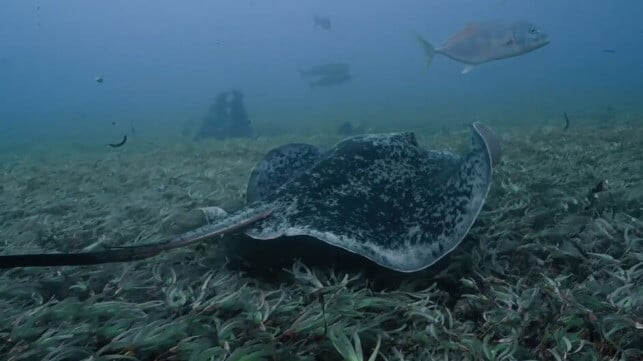Nestled in the Indian Ocean, the Saya de Malha Bank lies over 200 miles from any landmass, sandwiched between Mauritius and Seychelles.Spanning an area comparable to Switzerland, this remarkable seagrass meadow is one of the largest on Earth and serves as a vital carbon sink.Just like trees absorb CO2 from our atmosphere, seagrasses do it even more efficiently—35 times faster than tropical rainforests! This makes them essential for combating climate change. Unluckily, due to its remote nature, this underwater treasure remains largely unexplored and is currently facing severe threats from unmonitored fishing fleets.
The name “Saya de Malha,” which translates to “mesh skirt,” was given by Portuguese sailors over 500 years ago when they first spotted its lush seagrass swaying beneath the waves. In 2012, UNESCO recognized its unique ecological value and proposed it as a potential Marine World Heritage site.
Seagrasses often fly under the radar; they cover only about 0.1% of ocean floors but play a crucial role in marine ecosystems. ronald Jumeau, Seychelles’ Climate Change Ambassador, aptly calls them “the forgotten ecosystem.” Alarmingly, only about 26% of these meadows are protected compared to higher percentages for coral reefs (40%) and mangroves (43%).
Often referred to as the ocean’s lungs, seagrasses capture around 20% of marine carbon emissions while supporting diverse life forms—many still undiscovered! Sadly, since the late 1800s we’ve lost nearly one-third of these vital plants at an alarming rate: approximately seven percent annually or about a football field every half hour!
A report from UC Davis highlights that seagrass also plays a key role in filtering polluted waters and shielding coastlines against erosion. With millions of tons of plastic entering oceans yearly—around eight million—the dense structure of seagrass acts like a net that traps microplastics within sediment layers. Additionally, during times when ocean acidification threatens coral reefs and their inhabitants—including fish species—seagrasses help mitigate acidity through photosynthesis while providing critical habitats for endangered creatures like dugongs and sharks.
The situation at Saya de Malha is dire; over 200 distant-water fishing vessels primarily from Sri Lanka and Taiwan have been operating near its edges recently targeting tuna among other species for fishmeal production—a protein-rich animal feed ingredient. Conservationists argue that efforts to protect this precious habitat are lagging behind urgent needs: “It’s akin to walking north on a southbound train,” remarks Heidi Weiskel from IUCN’s Global Ocean Team.
A significant step was taken on May 23rd when the UN General Assembly declared March 1st as World Seagrass Day—a resolution backed by Sri Lanka itself! During his speech at this assembly highlighting their importance in carbon sequestration efforts, Ambassador Mohan Pieris noted how valuable these ecosystems are globally—but actions speak louder than words; simultaneously occurring ships representing his nation were thousands of miles away damaging those very ecosystems he advocated for.
ian Urbina leads The Outlaw Ocean Project based in Washington D.C., focusing on investigative journalism related to human rights issues along with environmental concerns across our planet’s vast oceans.
The views expressed hear belong solely to the author and do not necessarily reflect those held by The Maritime Executive.


Comments are closed, but trackbacks and pingbacks are open.